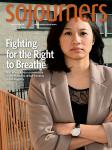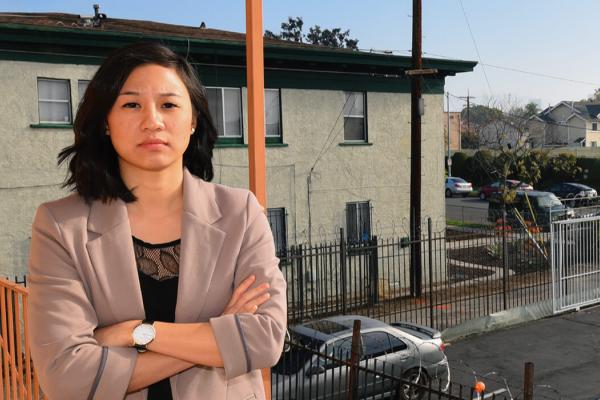THE FAMILIES SHOWED up early for the South Los Angeles planning commission meeting in late January. Parents stood in the back, soothing crying babies. A young girl leaned over a chair, coloring in a house with bright pink solar panels on a purple roof. “Clean energy can come from the sun,” her page read.
They showed up in force to oppose an oil company’s appeal to new and revised zoning restrictions on the Jefferson drill site, an oil field in their neighborhood. They lined up to share stories of the nauseating smells, disruptive noises, concerns about the risk of catastrophic explosion, and fears of the drill site’s long-term health impacts on their children.
When Niki Wong approached the microphone, she asked everyone against the oil field to stand. “Tonight families, children, and residents are here to stand for a healthy future,” she said, as nearly all the 70 attendees—except for the five representatives of the oil company—rose behind her.
Wong lives within a half mile of the drill site and walks by it every day. As the lead community organizer with Redeemer Community Partnership, a Christian community development corporation that has been working in South Los Angeles since 1992, she speaks not only for herself but also for her whole community.
Her faith community’s fight against the drill site represents a distinctive approach to ministry, one that introduces Christians to new social issues, including environmental justice. Embedding themselves into the community has allowed Wong and Church of the Redeemer, an Evangelical Covenant Church, to become powerful advocates for change.
At the appeals hearing, when the representatives of Sentinel Peak Resources, which bought the Jefferson drill site in 2017, described themselves as a “good neighbor,” Wong was incredulous. A native of Sugar Land, Texas, Wong is intimately familiar with the energy industry. Both of her parents and many friends work in jobs related to the industry.
When she tells friends about her work, she lays out the facts: The drill site operates in an area with a density of more than 30,000 people per square mile, with nothing but an 11-foot-high wall between the site and the multifamily residences next door. Church of the Redeemer meets in a school a couple of blocks away. Most residents are people of color and living in poverty. They are renters, nearly half holding less than a high school education, and about a quarter do not speak English.
“The desire and need for fossil fuels is creating sacrifice zones, and my neighborhood is one of them,” Wong tells them. “Part of what it means to be a Christian is thinking about these things and making decisions that would be in line with what is just and what takes care of people on the margins.”
Environmental issues are not necessarily Wong’s passion. Rather, it is her faith that drives her interest in the impact of the drill site—and climate change more broadly—on vulnerable people.
Face to face with inequality
Wong first came face to face with inequality on a mission trip in Texas in sixth grade. She continued going on mission trips every year, culminating in nearly three weeks in Kenya and Uganda as a senior in high school. “Coming back to Sugar Land, I was so angry that we had straight sidewalks,” she says of her experience seeing slums in Africa.
But she felt alone in that anger.
In college, InterVarsity Christian Fellowship helped her with her feelings. “It was really comforting to know that part of that anger comes from who God is and what it means to follow Jesus—that Jesus had those same feelings when he saw injustice happening, that he had to do something about it,” Wong says.
On a mission trip to Manila, the Philippines, during college, Wong discovered a different approach to what it meant to “do something.” There, “mission” wasn’t about dropping in, volunteering, and leaving—it was about seeking the holistic transformation of a community.
This introduction to “incarnational” service changed Wong’s course. She switched her major from biochemistry and molecular biology to urban studies. She abandoned her plans for medical school and instead pursued a master’s degree in public health. She wanted to help whole communities rather than just one patient at a time.
Wong and her husband began considering programs that would allow them to tie “your life and your future to the experience of the community,” as she puts it.
This is the model of the Redeemer community.
‘We didn’t know how toxic this was’
Like Wong, Richard Parks grew up in a wealthy suburb. When he first arrived in South Los Angeles as a student at the University of Southern California, he felt uncomfortable with the poverty surrounding the school. He joined InterVarsity and found Jesus’ words to be a compelling guide for his life—until he heard the commandment to “love your neighbor.”
“I thought, ‘Wow, I know who my neighbors are and I don’t love them, and I’m not sure I want to,’” Parks says. “I had to make a decision. Am I going to trust and see that his words are good here as well, or am I going to walk away from everything?”
Jesus’ commandment and the example of the early disciples in Acts inspired Parks and a few friends to move off campus and into the University Park neighborhood. They opened their doors to homeless people, tutored youth, and closed liquor stores. They started both Church of the Redeemer and Redeemer Community Partnerships, of which Parks is president.
And for 20 years, they lived blocks away from the Jefferson drill site.
Then, around 2014, Parks saw a permit application to drill three new wells and operate them 24-7. He and his team went door-to-door to ask neighbors about the drill site and discovered that strong fumes, fires, and oil spraying on homes and cars worried residents.
The city had previously waived public hearings for the drill site, but this time Redeemer Community Partnership and residents showed up to the public hearing, and the permit was denied. “That was just the tip of the iceberg,” Parks says. “At that point, we didn’t really know about how toxic this land-use was and its impact on residents. [We thought] it really was more of a nuisance.”
Wong and her husband first met Parks in spring 2014 while searching for their next ministry site. Parks gave them a neighborhood tour, pointing out the Jefferson drill site. As he shared some the chemicals he had learned about, “all these alarms went off in my head,” Wong says. With a background in biochemistry, urban studies, and public health, she understood the impact they could have on the people who lived around the site. “I remember leaning over to my husband on the walking tour and saying, ‘If we decide to move here, I’m going to work on this issue with that guy,’” she says. Wong and her husband moved to Los Angeles that summer, and Redeemer Community Partnership hired her as an organizer.
The chemicals next door
Around the same time, Liberty Hill Foundation, a local social justice organization, also turned its attention to urban drilling in Los Angeles. It helped fund individual efforts against drill sites, including Wong’s position at Redeemer. It also put together STAND-LA (Stand Together Against Neighborhood Drilling-Los Angeles), a coalition of activists fighting the same issues across a variety of neighborhoods in Los Angeles.
According to a 2015 report by Liberty Hill (“Drilling Down”), there were more than 5,000 active oil wells in about 70 drill sites across the County of Los Angeles as of 2014. Oil had built the city of Los Angeles, once the center of the world’s oil production. Today, the LA basin produces 28 million barrels per year, on land as well as offshore.
Production goes up and down with the price of oil, but the easiest oil to extract is gone, according to John Fleming, staff scientist at the Center for Biological Diversity. “Over time, there’s been an increased use of ‘enhanced oil recovery techniques,’” he says.
While the negative impacts of hydraulic fracturing, or “fracking,” have become well known, lesser-known enhanced techniques, such as acidification and gravel-packing a well, can be just as problematic, Fleming says. According to a report he authored (“Danger Next Door”), oil companies used more than 98 million pounds of toxic air pollutants in Los Angeles County between June 2013 and February 2017 as part of the extraction process. The known air toxics most frequently used by oil companies in the Los Angeles air basin include crystalline silica, methanol, hydrofluoric acid, and formaldehyde—the “trade secret” chemicals are unknown.
“Imagine actually driving those chemicals through neighborhoods,” Fleming says. “There isn’t a way to [drill] without using these chemicals and endangering people in these neighborhoods that are nearby, therefore it shouldn’t be happening.”
Little research has been done about the impact of drill sites in Los Angeles or any highly urbanized area. Sentinel Peak Resources representatives call the neighbors’ complaints “unsubstantiated.”
Wong has put her academic background to use, serving as a community partner on new research projects to fill the gap. A 2018 study in The International Journal of Environmental Research and Public Health , to which Wong contributed, found a significantly increased rate of asthma in the area surrounding the Jefferson drill site (which operates 36 wells on less than two acres), compared to the broader neighborhood (20.3 percent vs. 9.8 percent). More than a quarter of the residents surveyed reported that oil-related odors prevented daily activities.
The Redeemer community is particularly concerned with chemicals known to be carcinogens and endocrine-blockers, which can cause birth defects. The local study did not gather enough data about birth outcomes for analysis, but other studies find correlations between proximity to drill sites and low birth weights, birth defects, and reduced health of infants.
The “precautionary principal” in the field of public health suggests change is necessary now, Wong says. “We don’t have to wait for concrete connections between this particular chemical causing cancer in this particular neighbor to act.”
Wong authored a paper in 2017 summarizing studies on the health impacts of oil production elsewhere in the United States, mostly in rural areas. Due to the correlation between the distance of wells from homes and elevated risk of health effects, those studies recommend setbacks of 1,320 to 8,202 feet from active drill sites. Clearing just 1,500 feet around an oil well in South LA, according to Wong, would require the evacuation of 100,000 people. Currently, the Jefferson oil and waste-well site operates as close as 60 feet from homes, according to residents.
From oil wells to skate parks
STAND-LA is asking the LA City Council for a 2,500-foot setback from any oil well to houses or sensitive land uses. If approved, it would effectively shutter the Jefferson drill site and others in densely populated areas.
“We believe that fundamentally a drill site is not compatible with a residential neighborhood,” Wong says. “It never should have been built there.”
While STAND-LA works on this bigger goal, “it’s hand-to-hand combat in the trenches,” says Angela Johnson Meszaros, a lawyer with EarthJustice who works with Redeemer Community Partnership. “You have to do something now.”
In 2016, Johnson Meszaros helped Redeemer petition the city to address their complaints. After a hearing, the city’s zoning administrators revised and added to the 1960s rules that governed the site. The new rules require a 45-foot-high permanent enclosure, soundproofing, and electric rigs (to reduce diesel exhaust), measures that are already in place at drill sites in whiter and wealthier West LA neighborhoods.
“There’s this clear environmental racism at work,” Parks says. The city hasn’t always looked out for residents, he and Johnson Meszaros agree, but it is paying attention now.
In January, the city planning commission upheld all the new and revised regulations. “The community speaking here was very telling and impactful on me,” commission president Eric Bates said at the meeting, concluding the board’s unanimous vote against Sentinel Peak Resources’ appeal.
Having a faith community involved in the struggle reminds city leaders of their moral responsibilities, says Maya Golden-Krasner, senior attorney with the Center for Biological Diversity. She noted, however, that Los Angeles’ faith community is not a united front on this issue. The nearby AllenCo Energy and Murphy drill sites are on land owned by the Roman Catholic Archdiocese of Los Angeles. Environmental organizations, residents, and other faith leaders have pointed to Pope Francis’ leadership on climate change to push the archdiocese to terminate its leases with oil companies, but have so far been unsuccessful.
Redeemer Community Partnership is the first faith-based organization that Johnson Meszaros has worked with as an environmental advocate. She admires the clarity of purpose and perseverance that their faith gives them—and they will need it. The company is likely to sue, arguing the city is violating its vested interests with the restrictions, Johnson Meszaros says.
Wong says they are in it for the long haul. “Our church is really committed to being part of God’s work in this neighborhood to renew and restore it,” she says.
Days after the hearing, Wong was back canvassing the community. When she told people the news, everyone said the same thing: “That’s great we’ve got new rules, but when is it going to close?” Someday, Wong hopes to invite them to a different sort of community meeting about the Jefferson drill site—one where they get to decide what to do with the site.
“Right now, it is land use that repels people from the neighborhood,” she says. “I would love to see the site turn into something that brings the community together.”
The kids have already told her what they want: a skate park.

Got something to say about what you're reading? We value your feedback!

